Identification of Nutrient Deficiencies at Calcareous Soils for Maize
Main Article Content
Abstract
Identification of nutrient deficiencies at calcareous soils for maize (D Nursyamsi): A pot experiment was conducted to identify nutrient deficiencies at calcareous soils for maize (Zea mays, L.) in green house of Indonesian Soil Research Institute using top soil (0-20 cm) samples taken from Bogor (Typic Hapludalfs) and Blora (Typic Haplustalfs). The experiment used Randomized Completely Block Design, minus one test with 12 treatments and three replications, as well as maize of P21 variety as plant indicator. The results showed that use of N, P, K, Zn, Cu, Fe, and Mn fertilizers increased soil macro nutrients, i.e.: soil total-N, Olsen-P, HCl-P, and HCl-K, as well as soil micro nutrients, i.e.: soil DTPA-Zn, Cu, Fe, and Mn at both tested soils. Use of maize straw compost increased soil organic-C, total-N, HCl-K, and exchangeable Ca at Typic Hapludalfs and increased only soil organic-C and total-N at Typic Haplustalfs. Use of animal manure compost increased soil organic-C, exchangeable Ca and Mg, and CEC. Use of N, P, K, S, Zn, Cu, Fe, and Mn fertilizers increased each plant nutrients uptake at the soils. Use of both organic matters increased plant N, P, K, and Fe uptake at Typic Hapludalfs as well as increased only plant N, P, and K uptake at Typic Haplustalfs. Identification result showed that maize growth suffered from N, P, and K deficiencies at Typic Hapludalfs as well as N and P deficiencies at Typic Haplustalfs. Beside the nutrients, soil organic matter was also found out as limiting factor for maize growth in the soils.
Downloads
Download data is not yet available.
Article Details
Section
Articles
License for Authors
Authors who publish with this journal agree to the following terms:
- Authors retain copyright and grant the journal right of first publication with the work simultaneously licensed under a Creative Commons Attribution License that allows others to share the work with an acknowledgement of the work's authorship and initial publication in this journal.
- Authors are able to enter into separate, additional contractual arrangements for the non-exclusive distribution of the journal's published version of the work (e.g., post it to an institutional repository or publish it in a book), with an acknowledgement of its initial publication in this journal.
- Authors are permitted and encouraged to post their work online (e.g., in institutional repositories or on their website) prior to and during the submission process, as it can lead to productive exchanges, as well as earlier and greater citation of published work (See The Effect of Open Access).
License for Regular Users
Other regular users who want to cite, distribute, remix, tweak, and build upon author’s works, even for commercial purposes, should acknowledge the work’s authorship and initial publication in this journal, licensed under a Creative Commons Attribution License.
How to Cite
Identification of Nutrient Deficiencies at Calcareous Soils for Maize. (2018). JOURNAL OF TROPICAL SOILS, 15(3), 203-212. https://doi.org/10.5400/jts.2010.v15i3.203-212

